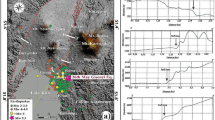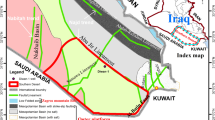Abstract
This study is aimed to elucidate individual fault response and peculiar earthquake characteristics in complex seismotectonic environment of southern Pakistan (Balochistan, Sindh and frontal offshore areas). The southern Pakistan is a seismic-mélange wherein earthquake prone sources are diversified and closely associated with active plate margins. The spatial patterns of seismicity are significant in reckoning seismic potential of active fault lineaments in intraplate cohorts of Arabian, Eurasian and Indian plates. The tectonic earthquakes during the period of 325 B.C to February 2020 are compiled in a catalog. This updated catalog has been thoroughly processed by standard procedures necessary for magnitude coherency, main shocks declustering, magnitude completeness etc. Since, the faulty blocks are extending beyond international borders, a wide region is outlined for cataloging and thorough screening of fault lines. The fault lineaments are digitized after geo-referencing of structural and tectonic maps. A rigorous effort is made to review literature to gather allied data sets of plate kinematics, GPS constraints across faulty blocks and slip-sense during major events. Individual fault lines are examined carefully to discriminate seismicity yield by considering their geometry and influence of seismotectonic settings. The seismicity characteristics of fault lines are used to ascribe ‘seismicity index’ that helped to rank potential faults from I (least active) to V (highly active). Kernel density maps are prepared to allure vulnerable pockets of the fault lineaments for specific magnitude classes. Seismicity Index and Kernel density models are significant to analyze spatial changes in potential magnitude strength which may be pertinent for urban planners and developers to design earthquake resistant buildings in study area.




Similar content being viewed by others
References
Ahmed N, Ghazi S, Khalid P (2016) On the variation of b-value for Karachi region, Pakistan through Gumbel’s extreme distribution method. Acta Geod Geophys 51(2):227–235
Ahmed S, Solangi SH, Jadoon MSK, Nazeer A (2018) Tectonic evolution of structures in Southern Sindh Monocline, Indus Basin, Pakistan formed in multi-extensional tectonic episodes of Indian Plate. Geodesy Geodyn 9(5):358–366
Ainuddin S, Routray JK, Ainuddin S (2014) People’s risk perception in earthquake prone Quetta city of Baluchistan. Int J Disaster Risk Reduction 7:165–175
Al-Ahmadi K, Al-Amri A, See L (2014) A spatial statistical analysis of the occurrence of earthquakes along the Red Sea floor spreading: clusters of seismicity. Arab J Geosci 7(7):2893–2904
Ali M, Khan MJ (2015) GIS based study on seismicity of makran over 100 years. Int J of Econ Environ Geol 6(2):11–16
Altamimi Z, Métivier L, Collilieux X (2012) ITRF2008 plate motion model. J Geophys Res 117. https://doi.org/10.1029/2011JB008930
Ambraseys N, Bilham R (2003) Earthquakes and associated deformation in northern Baluchistan 1892–2001. Bull Seismol Soc Am 93(4):1573–1605
Ashadi AL, Harmoko U, Gatot Y, Kaka SI (2015) Probabilistic seismic-hazard analysis for central Java Province Indonesia. Bull Seismol Soc Am 105:3. https://doi.org/10.1785/0120140277
Aslam B, Naseer F (2020) A statistical analysis of the spatial existence of earthquakes in Balochistan: clusters of seismicity. Environ Earth Sci 79(1):41
Barnhart WD, Hayes GP, Briggs RW, Gold RD, Bilham R (2014) Ball-and-socket tectonic rotation during the 2013 Mw7. 7 Balochistan earthquake. Earth Planet Sci Lett 403:210–216
Bilham R, Lodi S, Hough S, Bukhary S, Khan AM, Rafeeqi SFA (2007) Seismic hazard in Karachi, Pakistan: uncertain past, uncertain future. Seismol Res Lett 78(6):601–613
Botev ZI, Grotowski JF, Kroese DP (2010) Kernel density estimation via diffusion. Ann Stat 38(5):2916–2957
Byrne DE, Sykes LR, Davis DM (1992) Great thrust earthquakes and aseismic slip along the plate boundary of the Makran subduction zone. J Geophys Res Solid Earth 97(B1):449–478
Chen Y, Liu J, Chen L, Chen Q, Chan LS (1998) Global seismic hazard assessment based on area source model and seismicity data. Nat Hazards 17(3):251–267
Clévédé E, Weissenbach D, Gotab B (2009) Distributed jobs on EGEE Grid infrastructure for an Earth science application: moment tensor computation at the centroid of an earthquake. Earth Sci Inf 2(1–2):97–106
Coffin MF, Gahagan LM, Lawver LA (1997) Present-day plate boundary digital data compilation. Institute for Geophysics. Technical Report No. 174 (1997), 5p. Updated in 2014
DeMets C, Gordon RG, Argus DF, Stein S (1990) Current plate motions. Geophys J Int 101(2):425–478
Dziewonski AM, Chou TA, Woodhouse JH (1981) Determination of earthquake source parameters from waveform data for studies of global and regional seismicity. J Geophys Res Solid Earth 86(B4):2825–2852
Ekström G, Nettles M, Dziewoński AM (2012) The global CMT project 2004–2010: Centroid-moment tensors for 13,017 earthquakes. Phys Earth Planet Int 200:1–9
Farhoudi G, Karig DE (1977) Makran of Iran and Pakistan as an active arc system. Geology 5(11):664–668
Frohling E, Szeliga W (2016) GPS constraints on interplate locking within the Makran subduction zone. Geophys Suppl Mon Not R Astron Soc 205(1):67–76
Garcia ME, Szeliga W, Bilham R (2006) Modeling vertical deformation associated with the 1931 Mach earthquake, Pakistan. Eos Trans AGU 87(52)
Gutenberg B, Richter CF (1956) Earthquake magnitude, intensity, energy, and acceleration: (Second paper). Bull Seismol Soc Am 46(2):105–145
Hadi S, Khan SD, Owen LA, Khan AS, Hedrick KA, Caffee MW (2013) Slip-rates along the Chaman fault: Implication for transient strain accumulation and strain partitioning along the western Indian plate margin. Tectonophysics 608:389–400
Heidarzadeh M, Satake K (2015) New insights into the source of the Makran tsunami of 27 November 1945 from tsunami waveforms and coastal deformation data. Pure Appl Geophys 172(3–4):621–640
Iqbal M, Helmcke D (2004) Geological Interpretation of Earthquakes Data of Zindapir Anticlinorium, Sulaiman Foldbelt, Pakistan. Pak J Hydrocarb Res 14:41–47
Kagan YY, Jackson DD (1994) Long-term probabilistic forecasting of earthquakes. J Geophys Res Solid Earth 99(B7):13685–13700
Kazmi A, Jan Q (1997) Geology and tectonics of Pakistan. Graphic Publishers, Santa Ana
Khan M, Khan MJ (2017) Geology and Petrography of Peridotites (Mantle Section) From Bela Ophiolite Balochistan, Pakistan. Bahria Univ. Res J of Earth Sci 2:16–22
Khan M, Kerr AC, Mahmood K (2007) Formation and tectonic evolution of the Cretaceous–Jurassic Muslim Bagh ophiolitic complex, Pakistan: Implications for the composite tectonic setting of ophiolites. J Asian Earth Sci 31(2):112–127
Khan S, Waseem M, Khan MA, Ahmed W (2018) Updated earthquake catalogue for seismic hazard analysis in Pakistan. J Seismol 22(4):841–861
Khan MJ, Ali M, Xu M, Khan M (2020) Seismicity evaluation of major strike-slip faults in Southern Pakistan. Acta Geophys. https://doi.org/10.1007/s11600-020-00447-8
Kopp C, Fruehn J, Flueh ER, Reichert C, Kukowski N, Bialas J, Klaeschen D (2000) Structure of the Makran subduction zone from wide-angle and reflection seismic data. Tectonophysics 329(1–4):171–191
Kukowski N, Schillhorn T, Flueh ER, Huhn K (2000) Newly identified strike-slip plate boundary in the northeastern Arabian Sea. Geology 28(4):355–358
Martin SS, Kakar DM (2012) The 19 January 2011 M w 7.2 Dalbandin earthquake, Balochistan. Bull Seismol Soc Am 102(4):1810–1819
Minshull TA, Edwards RA, Flueh ER (2015) Crustal structure of the Murray Ridge, northwest Indian Ocean, from wide-angle seismic data. Geophys J Int 202(1):454–463
Mokhtari M, Amjadi AA, Mahshadnia L, Rafizadeh M (2019) A review of the seismotectonics of the Makran Subduction Zone as a baseline for Tsunami Hazard Assessments. Geosci Lett 6(1):1–9
Nabi A, Liu X, Gong Z, Pervaiz K, Ali A, Khalil U (2019) Seismotectonic analyses of Karachi Arc, Southern Kirthar Fold Belt, Pakistan. Int J Econ Environ Geol 10(2):9–18
Nabi A, Liu X, Gong Z, Ali A (2020) Electrical resistivity imaging of active faults in palaeoseismology: case studies from Karachi Arc, southern Kirthar Fold Belt, Pakistan. NRIAG J Astron Geophys 9(1):116–128
Niamatullah M, Imran M (2009) Structural geometry and tectonics of southern part of Karachi Arc – A case study of Pirmangho and Lalji Area: AAPG search and disc. Article # 50581 (2012). Adapted from oral presentation at PAPG Annual Technical Conference, Islamabad
Page WD, Alt JN, Cluff LS, Plafker G (1979) Evidence for the recurrence of large-magnitude earthquakes along the Makran coast of Iran and Pakistan. Tectonophysics 52(1–4):533–547
Papazachos BC, Scordilis EM, Panagiotopoulos DG, Papazachos CB, Karakaisis GF (2004) Global relations between seismic fault parameters and Moment magnitude of earthquakes. Bull Geol Soc Greece XXXVI
Pararas-Carayannis G (2006) The potential of tsunami generation along the Makran Subduction Zone in the northern Arabian Sea: Case study: the earthquake and tsunami of November 28, 1945. Sci Tsunami Hazards 24(5):358–384
Quittmeyer RC, Jacob KH (1979) Historical and modern seismicity of Pakistan, Afghanistan, northwestern India, and southeastern Iran. Bull Seismol Soc Am 69(3):773–823
Qureshi IH, Shah SAA, Tariq MA, Khan MS, Ahsan SN, Akhtar MJ, Pasha MA, Khan IA, Khanzada MI (2001) Geological map of Karachi area. Geological Survey of Pakistan, Sindh
Rafi Z, Lindholm C, Bungum H, Laghari A, Ahmed N (2012) Probabilistic seismic hazard of Pakistan, Azad-Jammu and Kashmir. Nat Hazards 61(3):1317–1354
Rajendran K, Rajendran CP, Thakkar M, Tuttle MP (2001) The 2001 Kutch (Bhuj) earthquake: Coseismic surface features and their significance. Curr Sci :1397–1405
Ramanna CK, Dodagoudar GR (2012) Seismic hazard analysis using the adaptive Kernel density estimation technique for Chennai City. Pure Appl Geophys 169(1–2):55–69
Rani VS, Srivastava K, Srinagesh D, Dimri VP (2011) Spatial and temporal variations of b-value and fractal analysis for the Makran region. Mar Geodesy 34(1):77–82
Regard V, Hatzfeld D, Molinaro M, Aubourg C, Bayer R, Bellier O, Yamini-Fard F, Peyret M, Abbassi M (2010) The transition between Makran subduction and the Zagros collision: recent advances in its structure and active deformation. Geol Soc Lond Spec Publ 330(1):43–64
Sarwar G, Alizai A (2013) Riding the mobile Karachi arc, Pakistan: Understanding tectonic threats. J Himal Earth Sci 46(2)
Schelling DD (1999) Frontal structural geometries and detachment tectonics of the northeastern Karachi arc, southern Kirthar Range, Pakistan. Special Papers-Geological Society Of America 287–302
Scordilis EM (2005) Globally valid relations converting Ms, mb and MJMA to Mw. In: Meeting on Earthquake Monitoring and Seismic Hazard Mitigation in Balkan Countries. NATO ARW, Borovetz, Bulgaria, pp 11–17
Scott LM, Janikas MV (2010) Spatial statistics in ArcGIS. In: Handbook of applied spatial analysis. Springer, Berlin, pp 27–41
Shi Y, Bolt BA (1982) The standard error of the magnitude-frequency b value. Bull Seismol Soc Am 72(5):1677–1687
Siddiqui NK, Jadoon IAK (2013) Indo-Eurasian Plate collision and the evolution of Pak-Iran Makran Microplate, Pishin-Katawaz Fault Block and the Porali Trough. In Search and Discovery Article# 30265 (2013), PAPG/SPE Annual Technical Conference, 3–5 December 2012, Islamabad, Pakistan
Smith GL, Mcneill LC, Wang K, He J, Henstock TJ (2013) Thermal structure and megathrust seismogenic potential of the Makran subduction zone. Geophys Res Lett 40:1528–1533
Stock C, Smith EG (2002) Adaptive kernel estimation and continuous probability representation of historical earthquake catalogs. Bull Seismol Soc Am 92(3):904–912
Szeliga W, Bilham R, Schelling D, Kakar DM, Lodi S (2009) Fold and thrust partitioning in a contracting fold belt: Insights from the 1931 Mach earthquake in Baluchistan. Tectonics 28(5)
Szeliga W, Bilham R, Kakar DM, Lodi SH (2012) Interseismic strain accumulation along the western boundary of the Indian subcontinent. J Geophys Res 117:B08404. https://doi.org/10.1029/2011JB008822
Waseem M, Khan MA, Khan S (2019) Seismic sources for southern Pakistan and seismic hazard assessment of Karachi. Nat Hazards 99(1):511–536
Wiemer S (2001) A software package to analyze seismicity: ZMAP. Seismol Res Lett 72(3):373–382
Woo G (1996) Kernel estimation methods for seismic hazard area source modeling. Bull Seismol Soc Am 86(2):353–362
Acknowledgements
The open source agencies US Geological Survey and Harvard CMT- Lamont-Doherty Earth Observatory (LDEO), GEBCO, US Geological Survey and Pakistan Metrological Department are acknowledged for providing access to the desired datasets from their archives. The author is pleased to thankful to Prof. Dr. Mubarik Ali (Pakistan), Dr. Mohammad Mokhtari (Iran) and Dr. Rolodfo Console (Italy) for their critical suggestions and technical guidance to conduct this study. HoD of Earth & Environmental Sciences Department, Bahria University Karachi Campus is also acknowledged for his continuous motivation and facilitation to publish this work.
Author information
Authors and Affiliations
Corresponding author
Additional information
Communicated by: H. Babaie
Publisher’s note
Springer Nature remains neutral with regard to jurisdictional claims in published maps and institutional affiliations.
Rights and permissions
About this article
Cite this article
Khan, M.J. Modelling of seismicity in southern pakistan using GIS techniques. Earth Sci Inform 13, 1327–1340 (2020). https://doi.org/10.1007/s12145-020-00515-z
Received:
Accepted:
Published:
Issue Date:
DOI: https://doi.org/10.1007/s12145-020-00515-z




